Antiderivatives that Result in Logarithms
Recall How Deriving Logs Works
Suppose we want to find the derivative of the function \(f(x)=\ln(x^3+4)\). To do this, we need to employ the chain rule because we have a function inside another function: \(x^3+4\) is being plugged into the logarithm \(\ln(x)\). The result of deriving this is below:
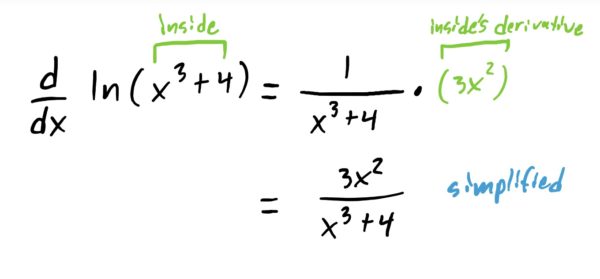
Notice that, in the final answer of the derivative performed above that the derivative of the denominator is what you see in the numerator. This is somewhat of a “signature feature” of derivatives of logarithms. When trying to find antiderivatives of fractions that have this feature, we thus know that the result will be a logarithm. Of course, we can carry out the process of antideriving using u-sub.
Antideriving these special fractions…
Suppose we want to compute
$$\int \frac{7x^6+2x+1}{x^7+x^2+x-6}\ dx$$
Notice first that the numerator is exactly the derivative of the denominator. Since we are trying to find a function that has this fraction as it’s derivative, and based on what we observed in the previous section, we know that this indefinite integral will be a logarithm with the denominator inside.
If we want to carry out this antiderivative using u-substitution, we can simply let the denominator of the fraction be our “inside function” and call it \(u\). Then, computing \(\frac{du}{dx}\) the substitution is very natural. See below for how this works out.
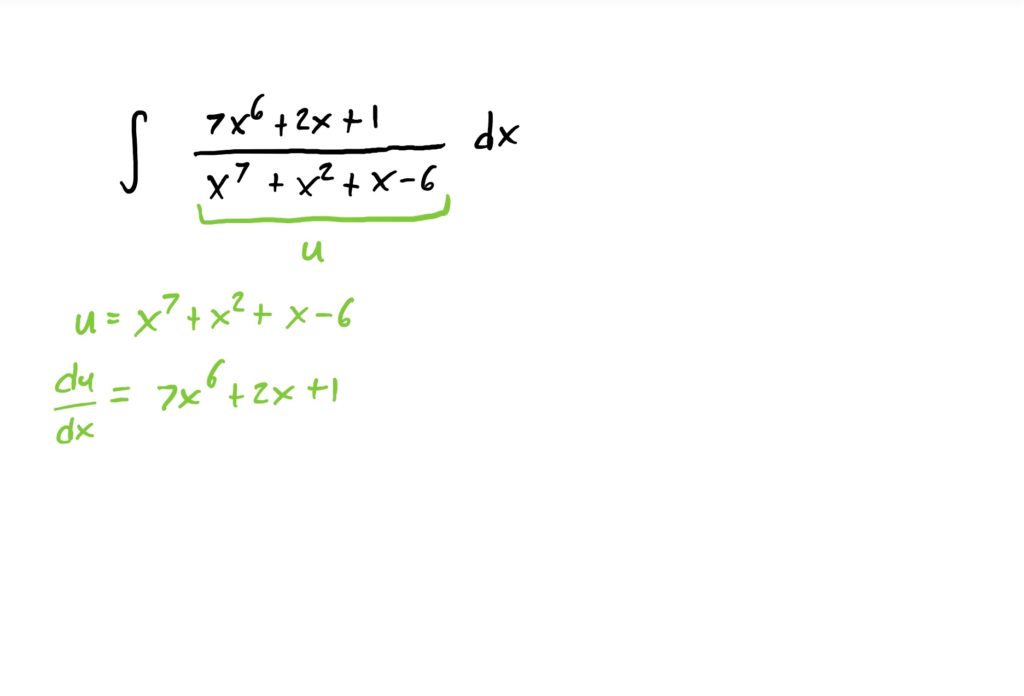
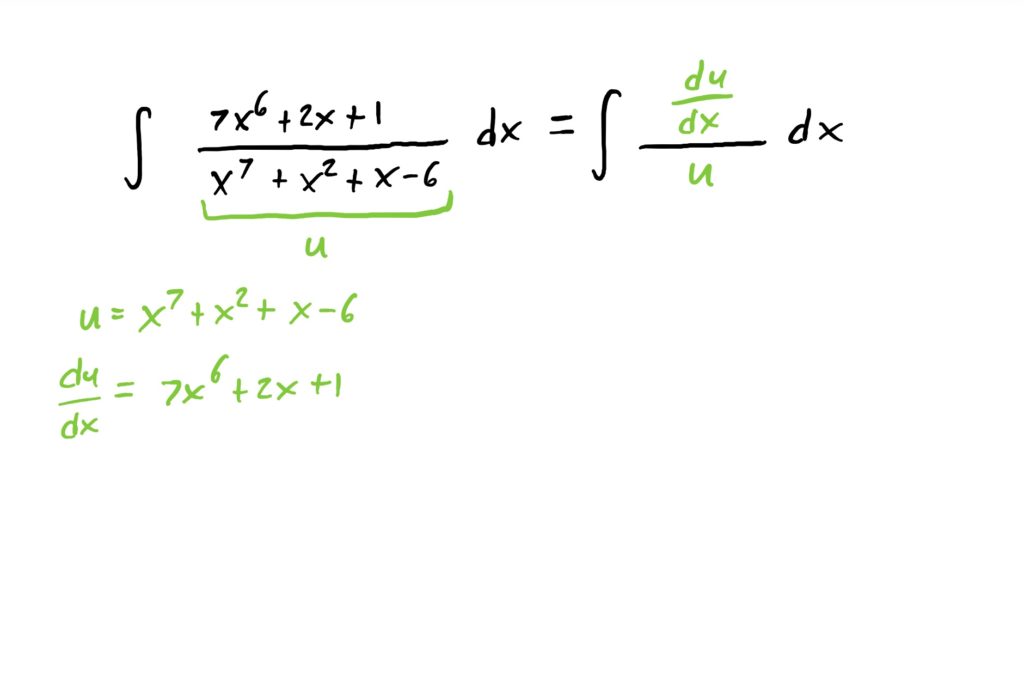
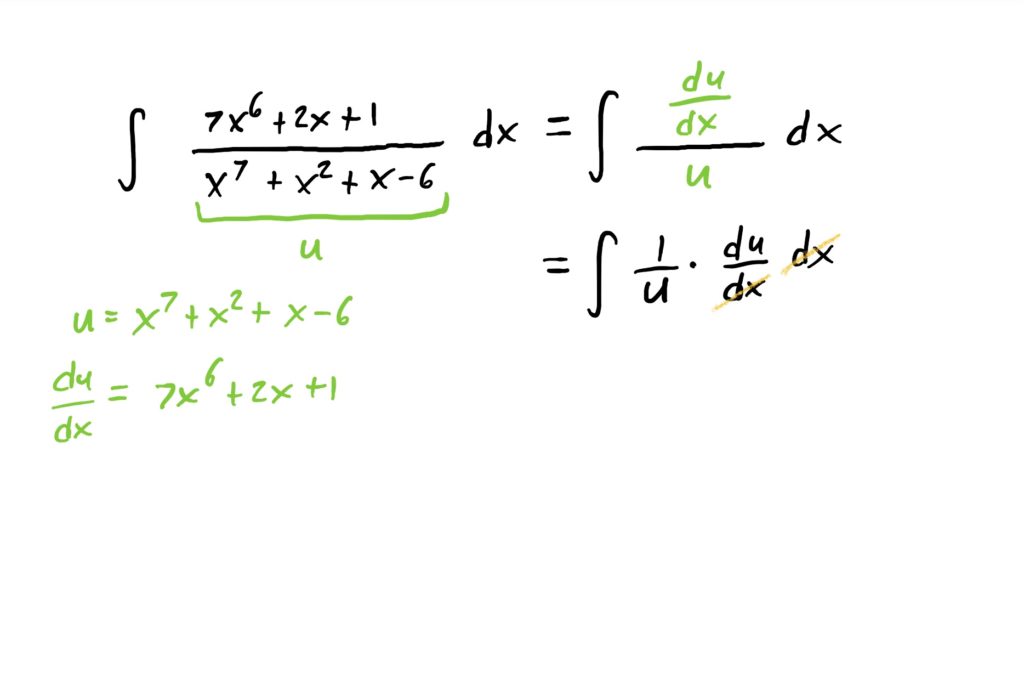
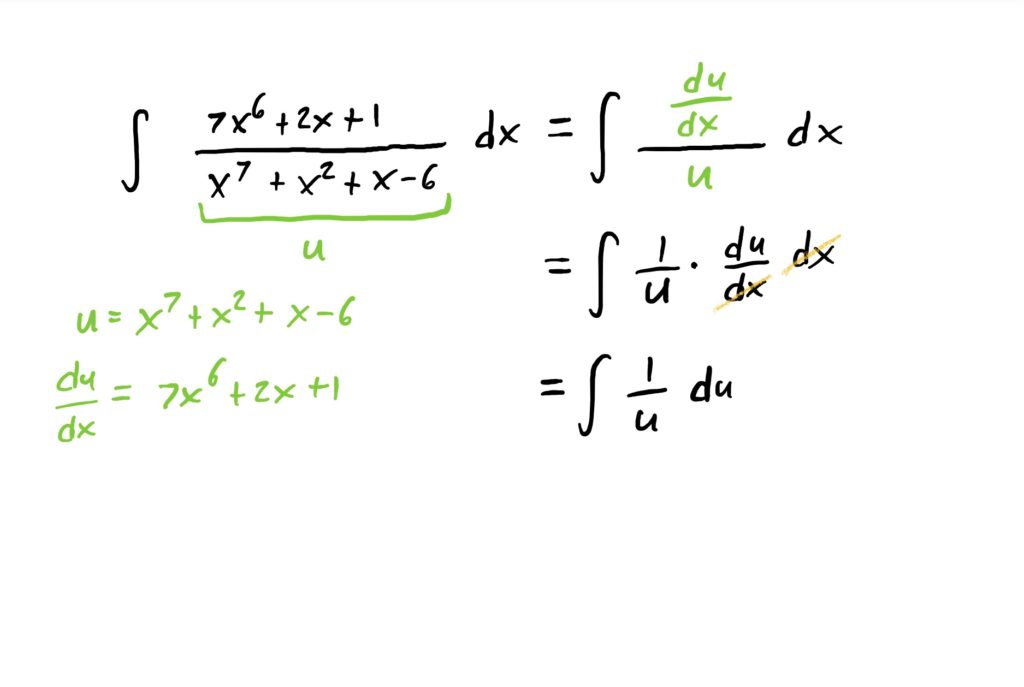
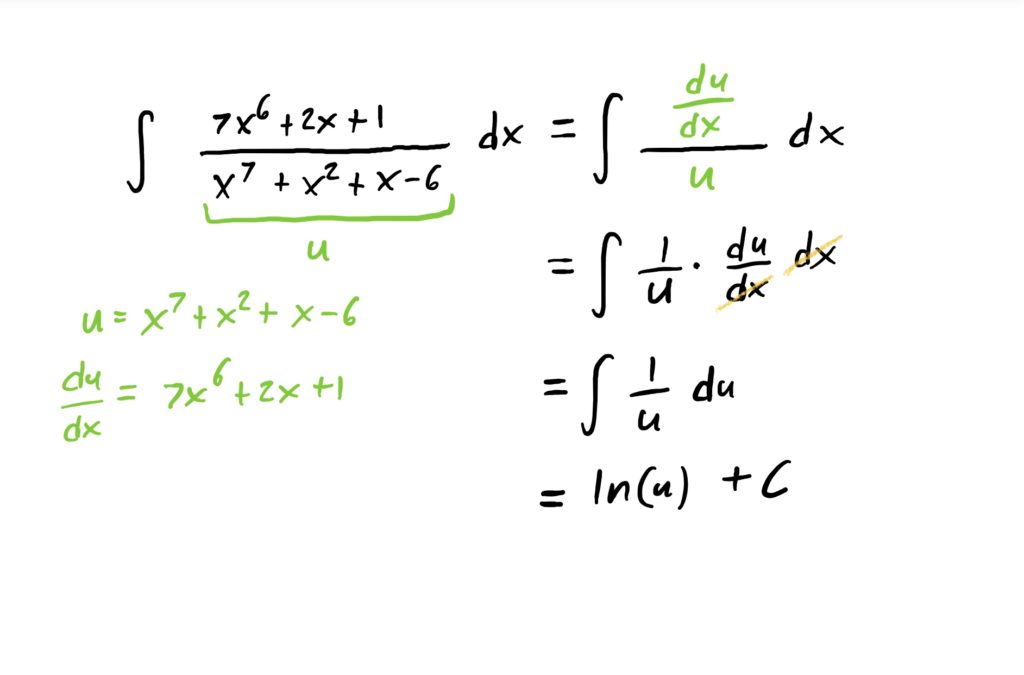
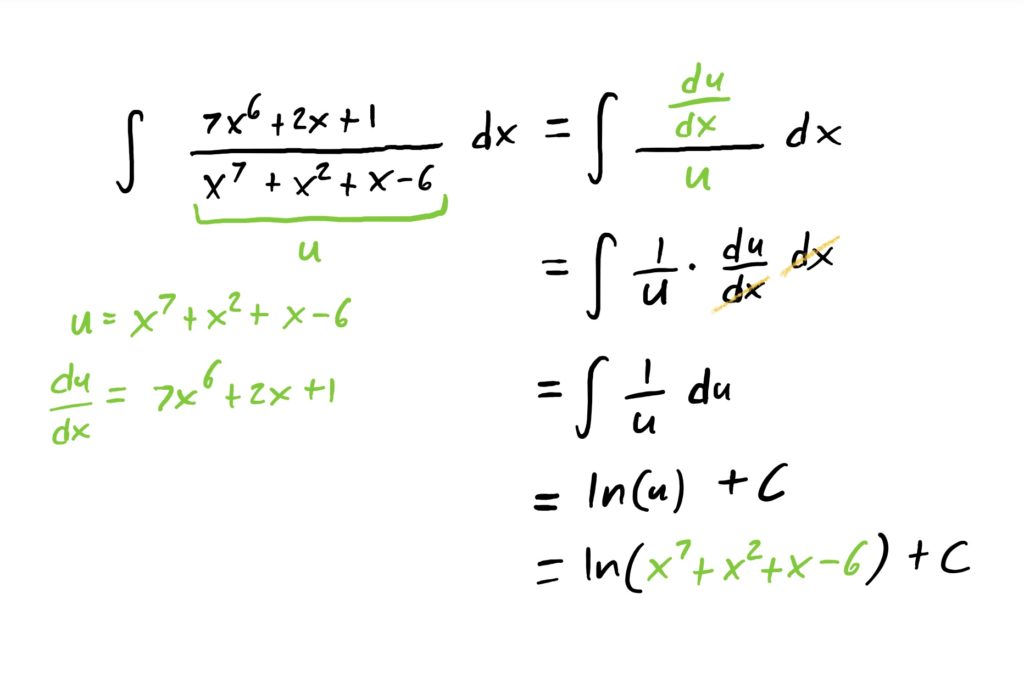
It should be noted that at times the numerator of these fractions is not exactly like the derivative of the denominator. If this happens, you might need to rearrange the \(\frac{du}{dx}\) equation or event the \(u\) equation so that wehn you carry out the substitution, there will be no more \(x\)-stuff remaining, leaving only an integral in terms of \(u\) to be computed.
Compute the following antiderivatives
Let \(u=x+1\).
- First find an “inside function” and let it be called \(u\).
- Find the derivative of \(u\), \(\frac{du}{dx}\)
- Find where the expressions you have for \(u\) and \(\frac{du}{dx}\) appear in the integral and replace them in the integrand with \(u\) and \(\frac{du}{dx}\). You may need to first rearrange the equations for \(u\) or \(\frac{du}{dx}\) before substituting. Your integral should have no \(x\)’s anymore after subbing.
- integrate as usual. Don’t forget “+C”
- plug back in your \(u\) formula and call it a day
- (If computing a definite integral, then plug in upper and lower limits in for \(x\), and subtract the results.)
\(\ln\vert x+1 \vert+C\)
Let \(u=x^2+1\)
- First find an “inside function” and let it be called \(u\).
- Find the derivative of \(u\), \(\frac{du}{dx}\)
- Find where the expressions you have for \(u\) and \(\frac{du}{dx}\) appear in the integral and replace them in the integrand with \(u\) and \(\frac{du}{dx}\). You may need to first rearrange the equations for \(u\) or \(\frac{du}{dx}\) before substituting. Your integral should have no \(x\)’s anymore after subbing.
- integrate as usual. Don’t forget “+C”
- plug back in your \(u\) formula and call it a day
- (If computing a definite integral, then plug in upper and lower limits in for \(x\), and subtract the results.)
\(\ln\vert x^2+1 \vert +C\)
Let \(u=\ln(x^2+1)\). Yes. Including the Log.
- First find an “inside function” and let it be called \(u\).
- Find the derivative of \(u\), \(\frac{du}{dx}\)
- Find where the expressions you have for \(u\) and \(\frac{du}{dx}\) appear in the integral and replace them in the integrand with \(u\) and \(\frac{du}{dx}\). You may need to first rearrange the equations for \(u\) or \(\frac{du}{dx}\) before substituting. Your integral should have no \(x\)’s anymore after subbing.
- integrate as usual. Don’t forget “+C”
- plug back in your \(u\) formula and call it a day
- (If computing a definite integral, then plug in upper and lower limits in for \(x\), and subtract the results.)
\(\frac{\ln(x^2+1)^2}{4}+C\)
Let \(u=\ln(x)\)
- First find an “inside function” and let it be called \(u\).
- Find the derivative of \(u\), \(\frac{du}{dx}\)
- Find where the expressions you have for \(u\) and \(\frac{du}{dx}\) appear in the integral and replace them in the integrand with \(u\) and \(\frac{du}{dx}\). You may need to first rearrange the equations for \(u\) or \(\frac{du}{dx}\) before substituting. Your integral should have no \(x\)’s anymore after subbing.
- integrate as usual. Don’t forget “+C”
- plug back in your \(u\) formula and call it a day
- (If computing a definite integral, then plug in upper and lower limits in for \(x\), and subtract the results.)
\(\ln\vert \ln \vert x \vert \vert +C\)
Let \(u=\ln(\sqrt{t})\)
- First find an “inside function” and let it be called \(u\).
- Find the derivative of \(u\), \(\frac{du}{dx}\)
- Find where the expressions you have for \(u\) and \(\frac{du}{dx}\) appear in the integral and replace them in the integrand with \(u\) and \(\frac{du}{dx}\). You may need to first rearrange the equations for \(u\) or \(\frac{du}{dx}\) before substituting. Your integral should have no \(x\)’s anymore after subbing.
- integrate as usual. Don’t forget “+C”
- plug back in your \(u\) formula and call it a day
- (If computing a definite integral, then plug in upper and lower limits in for \(x\), and subtract the results.)
\((\ln(\sqrt{t}))^2+C\)
Let the denominator be your \(u\)… or you can simplify the integrand to make your life real easy.
- First find an “inside function” and let it be called \(u\).
- Find the derivative of \(u\), \(\frac{du}{dx}\)
- Find where the expressions you have for \(u\) and \(\frac{du}{dx}\) appear in the integral and replace them in the integrand with \(u\) and \(\frac{du}{dx}\). You may need to first rearrange the equations for \(u\) or \(\frac{du}{dx}\) before substituting. Your integral should have no \(x\)’s anymore after subbing.
- integrate as usual. Don’t forget “+C”
- plug back in your \(u\) formula and call it a day
- (If computing a definite integral, then plug in upper and lower limits in for \(x\), and subtract the results.)
\(\frac{1}{6} \ln \vert (2x+1)^3 \vert +C\)
